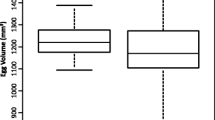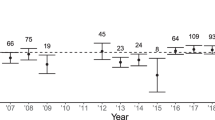Summary
Although several different hypotheses have been proposed to explain the evolution of helping behavior, most are based on the assumption that helping enhances the reproductive success of recipient breeders. I tested this assumption by removal experiments in the cooperatively breeding Florida scrub jay (Aphelocoma c. coerulescens). This species lives in permanently territorial social units containing a single breeding pair and none to six nonbreeders, which are usually offspring of the breeding pair and which usually act as helpers by feeding the nestlings and fledglings produced by the breeding pair. Although experimental removals of non-breeders in 1987–1988 had no significant effect on breeder survival, egg production, or hatching success, experimental groups suffered higher rates of predation on nestlings (1987) and lower rates of fledgling survival (both years) than did unmanipulated controls. As a result, experimental groups produced an average of only 0.56 independent juveniles, compared to 1.62 young for controls. Analysis of the factors contributing to nestling and fledgling mortality indicates that helping behavior per se (i.e., the aid that nonbreeders provide to dependent young), not the mere presence of nonbreeders, was responsible for the greater reproductive success observed in control groups. Because survival rates of allofeeders (i.e., those nonbreeders that provisioned dependent young) were virtually identical to those of non-allofeeders, the costs of helping behavior in this species appear to be small. Furthermore, nonbreeders are more likely to provision dependent young within their social unit when those young are closely related. I therefore conclude that nonbreeders increase their indirect fitness by serving as helpers and that helping behavior in the Florida scrub jay is a trait that has current selective utility. It remains debatable, however, whether helping in this species is an adaptation that has been shaped by the process of natural selection.
Similar content being viewed by others
References
Baum DA, Larson A (1991) Adaptation reviewed: a phylogenetic methodology for studying character macroevolution. Syst Zool 40:1–18
Brown JL (1987) Helping and communal breeding in birds: ecology and evolution. Princeton University Press, Princeton
Brown JL, Brown ER, Brown SD, Dow DD (1982) Helpers: effects of experimental removal on reproductive success. Science 215:421–422
Clarke MF (1989) The pattern of helping in the bell miner (Manorina melanophrys). Ethology 80:292–306
Clarke MF (1990) The pattern of helping in the bell miner revisited a reply to Jamieson and Craig. Ethology 86:250–255
Curry RL (1988) Influence of kinship on helping behavior in Galapagos mockingbirds. Behav Ecol Sociobiol 22:141–152
Emlen ST (1991) Evolution of cooperative breeding in birds and mammals. In: Krebs JR, Davies NB (eds) Behavioural ecology: an evolutionary approach, 3rd edn. Blackwell, Oxford, pp 301–337
Emlen ST, Wrege PH (1988) The role of kinship in helping decisions among white-fronted bee-eaters. Behav Ecol Sociobiol 23:305–315
Francis AM, Hailman JP, Woolfenden GE (1989) Mobbing by Florida scrub jays: behaviour, sexual asymmetry, role of helpers, and ontogeny. Anim Behav 38:795–816
Gould SJ, Vrba ES (1982) Exaptation — a missing term in the science of form. Paleobiology 8:4–15
Hamilton WD (1964) The genetical evolution of social behaviour. J Theor Biol 7:1–52
Heinsohn RG, Cockburn A, Mulder RA (1990) Avian cooperative breeding: old hypotheses and new directions. Trends Ecol Evol 5:403–407
Jamieson IG (1989) Behavioral heterochrony and the evolution of birds' helping at the nest: an unselected consequence of communal breeding? Am Nat 133:394–406
Jamieson IG (1991) The unselected hypotheses for the evolution of helping behavior: too much or too little emphasis on natural selection? Am Nat 138:271–282
Jamieson IG, Craig JL (1990) Reply: evaluating hypotheses on the evolution of helping behaviour in the bell miner, Manorina melanophrys. Ethology 85:163–167
Koenig WD, Mumme RL (1990) Levels of analysis and the functional significance of helping behavior. In: Bekoff M, Jamieson D (eds) Interpretation and explanation in the study of animal behavior. Vol II. Explanation, evolution, and adaptation. Westview, Boulder, pp 268–303
Leonard ML, Horn AG, Eden SF (1989) Does juvenile helping enhance breeder reproductive success? a removal experiment on moorhens. Behav Ecol Sociobiol 25:357–361
Magrath RD (1991) Nestling weight and juvenile survival in the blackbird, Turdus merula. J Anim Ecol 60:335–351
McGowan KJ (1987) Social development in young Florida scrub jays (Aphelocoma c. coerulescens). PhD dissertation, University of South Florida
McGowan KJ, Woolfenden GE (1989) A sentinel system in the Florida scrub jay. Anim Behav 37:1000–1006
McGowan KJ, Woolfenden GE (1990) Contributions to fledgling feeding in the Florida scrub jay. J Anim Ecol 59:691–707
Mumme RL (1991) Helping behaviour in the Florida scrub jay: nonaptation, exaptation, or adaptation? Acta XX Cong Int Ornithol: 1317–1324
Mumme RL, Koenig WD (1991) Explanations for avian helping behavior. Trends Ecol Evol 6:343–344
Rabenold KN (1990) Campylorhynchus wrens: the ecology of delayed dispersal and cooperation in the Venezuelan savanna. In: Stacey PB, Koenig WD (eds) Cooperative breeding in birds: long-term studies of ecology and behavior. Cambridge University Press, Cambridge, pp 157–196
Reyer H-U (1984) Investment and relatedness: a cost/benefit analysis of breeding and helping in the pied kingfisher (Ceryle rudis). Anim Behav 32:1163–1178
Schaub R, Mumme RL, Woolfenden GE (1992) Predation on the eggs and nestlings of Florida scrub jays. Auk 109:585–593
Schoech SJ, Mumme RL, Moore MC (1991) Reproductive endocrinology and mechanisms of breeding inhibition in cooperatively breeding Florida scrub jays (Aphelocoma c. coerulescens). Condor 93:354–364
Siegel S (1956) Nonparametric statistics for the behavioral sciences. McGraw-Hill, New York
Smith JNM (1990) Summary. In: Stacey PB, Koenig WD (eds) Cooperative breeding in birds: long-term studies of ecology and behavior. Cambridge University Press, Cambridge, pp 593–611
Solomon NG (1991) Current indirect fitness benefits associated with philopatry in juvenile prairie voles. Behav Ecol Sociobiol 29:277–282
Stacey PB, Koenig WD (1990) Cooperative breeding in birds: long-term studies of ecology and behavior. Cambridge University Press, Cambridge
Stallcup JA, Woolfenden GE (1978) Family status and contribution to breeding by Florida scrub jays. Anim Behav 26:1144–1156
Williams GC (1966) Adaptation and natural selection. Princeton University Press, Princeton
Woolfenden GE, Fitzpatrick JW (1984) The Florida scrub jay: demography of a cooperative-breeding bird. Princeton University Press, Princeton
Woolfenden GE, Fitzpatrick JW (1986) Sexual asymmetries in the life history of the Florida scrub jay. In: Rubenstein D, Wrangham RW (eds) Ecological aspects of social evolution: birds and mammals. Princeton University Press, Princeton, pp 87–107
Woolfenden GE, Fitzpatrick JW (1990) Florida scrub jays: a synopsis after 18 years of study. In: Stacey PB, Koenig WD (eds) Cooperative breeding in birds: long-term studies of ecology and behavior. Cambridge University Press, Cambridge, pp 239–266
Author information
Authors and Affiliations
Rights and permissions
About this article
Cite this article
Mumme, R.L. Do helpers increase reproductive success?. Behav Ecol Sociobiol 31, 319–328 (1992). https://doi.org/10.1007/BF00177772
Received:
Accepted:
Issue Date:
DOI: https://doi.org/10.1007/BF00177772




